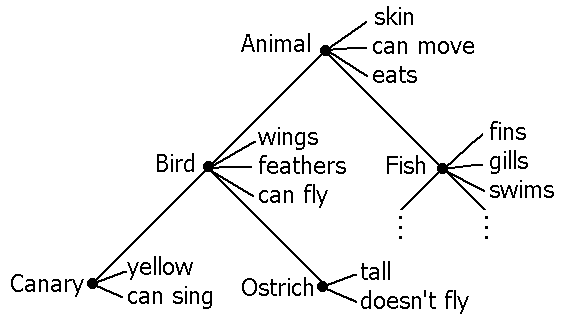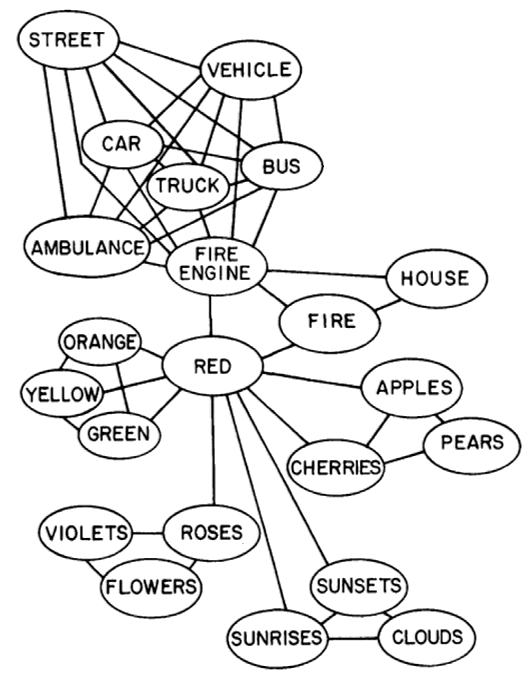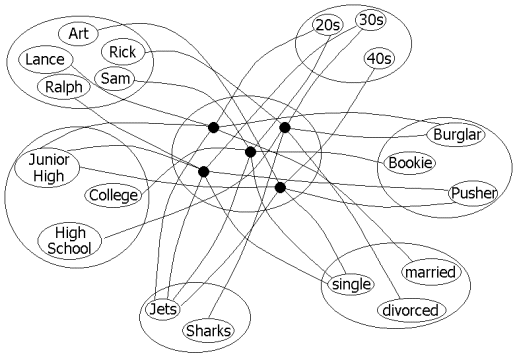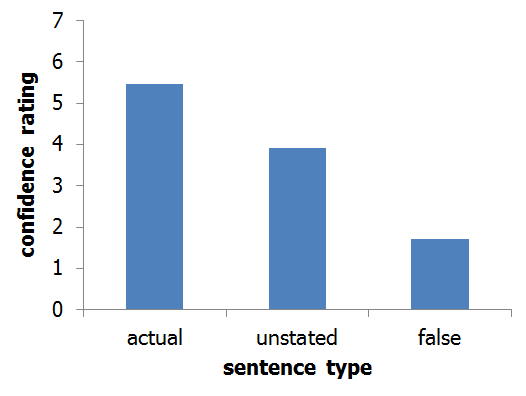1. How are natural categories different from the classical approach?
2. Describe the components of the following approaches to knowledge representation:
- prototypes
- exemplars
- feature comparison model
- semantic network models
- connectionist approach
3. Explain the pros and cons of each model.
4. What are some kinds of schemas? How do scripts and schemas affect memory?
________: class of objects, associated on the basis of some relationship
_______: mental representations of a category
- depends on ______________: identifying features common to all members of a conceptual class
- ______________: notice differences between conceptual categories
Bruner, Goodnow, & Austin (1956): benefits of categorization:
• reduces __________ of the environment
• means by which objects of the world are __________
• reduces need for constant ________
• allows us to decide what constitutes an appropriate ______
• enables us to order and relate _______ of objects and events
Assumptions:
• categorization based on lists of ________ ________: those that are necessary to the meaning of the item
e.g., a triangle is a closed, three-sided figure
• features are individually necessary and collectively sufficient
Pros & cons:
![]() distinction between different categories is clear and logical
distinction between different categories is clear and logical
![]() works for _______ categories:
works for _______ categories:
e.g., geometric shapes, prime numbers
![]() implies that all members are created _____
implies that all members are created _____
Assumptions:
• groupings or clustering of objects or concepts that occur naturally in the real world
• _____ borders; membership may overlap
e.g., what are the defining features for the concept _______?
Eleanor Rosch [née Heider] (1973)
Assumptions:
• items are comprised of a list of features or attributes
• concept organization based on _________: abstract, idealized item that is most typical category member
• ______________ features: describe the prototype, but are not necessary
• categorization of items is based on similarity to the prototype
• concepts are ______________ organized:
animals |
||
birds |
fish |
|
robin |
bluejay |
|
▸ _____________ level (e.g., fruit, animals)
- largest categories
- members of a category have few attributes in common
e.g., musical instruments
- tends to be abstract
▸ _____ level (e.g., grapes, apples)
- prototypes formed to represent the category
- members of a category share many attributes, and are highly differentiated from other basic categories
e.g., guitar, piano
- shows _______ ______: response is faster if item is preceded by a similar item
e.g., judgments about specific apples are faster if preceded by apple, than by fruit
- in general, people prefer to use basic-level names for things
- ________ learn basic level objects first (dogs), before they categorize in superordinate (animal) or subordinate (collie, hound)
▸ ___________ level (e.g., Thompson seedless, Concord)
- narrowest categories
- less ________ than basic categories
e.g., classical guitar, folk guitar
- _______ prefer to use subordinate-level terms; greater expertise ![]() greater use of sub-subordinate terms (Johnson & Mervis, 1997)
greater use of sub-subordinate terms (Johnson & Mervis, 1997)
Evidence:
• __________ effect: items differ in how well they represent a category
e.g., rank order these items in their category:
vehicles: car, elevator, sled, tractor, train
clothes: jacket, mittens, necklace, pajamas, pants
• ______ ___________: each item has at least one shared attribute with another item in the category; is a kind of typicality
- good members of a category share many attributes with members of the same category
- but share few attributes with members of other categories
Rosch & Mervis (1975):
- generated list of category members
e.g., fruit: apple, banana, coconut, olive, orange, tomato
- asked participants to rate typicality of each member within category
e.g., apple as a member of fruit
- others listed attributes of category members
e.g., apple: red, sweet, crunchy, round
- strong correlations found between typicality rating and number of attributes shared by other category members
e.g., r = .85 for fruit (also, r = .88 for furniture, r = .91 for clothing)
- ______ ___________ is important to typicality
• brain activity
Kosslyn, Alpert, & Thompson (1995):
- participants placed in PET scanner
- saw picture of an item, and heard a word (e.g., “toy,” “doll,” or “rag doll”
- superordinate terms more likely to activate part of the __________ cortex (language, associative memory)
- subordinate terms more likely to activate visual attention areas
Pros & cons:
![]() accounts for concepts representing _____ groups
accounts for concepts representing _____ groups
e.g., games--merely share a family resemblance
![]() allows for ___________
allows for ___________
![]() explains how information is _______ to a single, idealized abstraction
explains how information is _______ to a single, idealized abstraction
![]() but we also store ________ information about individual examples
but we also store ________ information about individual examples
![]() number of potential ________ is very large (infinite?)
number of potential ________ is very large (infinite?)
![]() what determines feature weights?
what determines feature weights?
![]() how does expertise change categories?
how does expertise change categories?
![]() counterintuitively implies categories have fuzzy boundaries
counterintuitively implies categories have fuzzy boundaries
Assumptions:
• _________: members of a category that you have previously encountered (vs. prototypes, which are idealized)
e.g., dog concept is based on actual dogs you’ve seen
• first you learn specific exemplars of a category, then you classify new items based on their similarity to the exemplars
Heit & Barsalou (1996):
- asked participants for exemplars of various categories of animals
- measured exemplars’ typicality, and how typical the categories were of animals
- strongly correlated: r = .92
(_______ are most typical; ______________ the least)
- implication: our concepts are based on the most typical (i.e., exemplary) items
Pros & cons:
![]() accounts for typicality effect
accounts for typicality effect
![]() no
lists of features needed
no
lists of features needed
![]() no abstraction process needed
no abstraction process needed
![]() allows for “__________” to categories
allows for “__________” to categories
e.g., penguins as birds
![]() good for categories with ___ members
good for categories with ___ members
![]() requires vast storage for individual members of large categories
requires vast storage for individual members of large categories
(Smith, Shoben, & Rips, 1978)
Assumptions:
• concepts represented as a set of features:
bird: |
robin: |
wings |
wings |
feathers |
feathers |
... |
red breast |
... |
... |
• ________ features: essential, required features of a concept; are at the top of the feature list
• ______________ features: descriptive, but not essential (“loosely speaking”); are at the bottom of the list
e.g., birds:
- defining features = wings, feathers,...
- characteristic features = fly, sing,...
• ________ ____________ task: measure RT to correctly respond true or false to a given sentence
e.g., “A robin is a bird.” = true
• relations between concepts are computed based on shared features; more features ![]() slower RTs
slower RTs
• two-stage model:
Stage 1: compare ___ features (fast comparison) |
||||||
low overlap |
medium overlap |
high overlap |
||||
Stage 2: compare ________ features (slow comparison) |
||||||
“false” |
mismatch |
match |
“true” |
|||
Pros & cons:
![]() typicality effects: faster RT when item is a typical member of
a category
typicality effects: faster RT when item is a typical member of
a category
e.g., “A robin is a bird.” (faster than) “A penguin is a bird.”
![]() ____/_____ effect: quick rejection of false sentences
____/_____ effect: quick rejection of false sentences
e.g., “A pencil is a bird.” (faster than) “A bat is a bird.”
![]() doesn’t explain ________
____ effect: faster RT when item is member of a small category
doesn’t explain ________
____ effect: faster RT when item is member of a small category
e.g., “A robin is a bird.” (faster than) “A robin is an animal.”
- small categories have more defining features ![]() more stage 2 processing
more stage 2 processing ![]() slower
slower
![]() can account for __________ of category size effect:
can account for __________ of category size effect:
e.g., “Scotch is a liquor.” (slower than) “Scotch is a drink.”
![]() not all defining features of a category are necessary
not all defining features of a category are necessary
e.g., “Is a robin with no wings still a bird?”
![]() features poorly _______; characteristic features have circular definition
features poorly _______; characteristic features have circular definition
Common assumptions:
• concepts represented in network of interconnected _____
• concept defined in terms of ___________ to other concepts
Hierarchical-Network Model (Collins & Quillian, 1969)

Assumptions:
• ____ represents a single concept
• concepts organized hierarchically
• pathways represent associations between concepts
- “___” pathways: express category membership
- “____” pathways: express properties
• properties stored at the most general (“highest”) level possible, with no redundancy (cognitive economy)
• sentence verification via ____________ ______:
- “A canary is a bird.”
- “canary” and “bird” activated; activity spreads to neighbours
- both spreads eventually intersect, allowing answer to be made
Pros & cons:
![]() cognitive economy:
cognitive economy:
e.g., “A bird has feathers.” (faster than) “A bird has skin.”
![]() corresponds well with category size effect:
corresponds well with category size effect:
e.g. “A canary...”
Category |
Property |
||
“...is a canary.” |
1,000 ms |
“...can sing.” |
1,350 ms |
“...is a bird.” |
1,200 ms |
“...can fly.” |
1,400 ms |
“...is an animal.” |
1,300 ms |
“...has skin.” |
1,500 ms |
![]() doesn’t explain violations of category size effect:
doesn’t explain violations of category size effect:
e.g., “A dog is a mammal.” (slower than) “A dog is an animal.”
![]() typicality effects (model predicts they should not be obtained):
typicality effects (model predicts they should not be obtained):
e.g., “A robin is a bird.” (faster than) “An ostrich is a bird.”
Spreading Activation Model (Collins & Loftus, 1975)

Assumptions:
• not hierarchical
• link length represents degree of relatedness; search time depends on link length
• passive concepts not in working memory; active ones are
• _________ __________: activation of one node leads to (partial) activation of connected nodes
• degree of activation decreases over distance and time
Pros & cons:
![]() accounts for: category size effects (& violations), typicality effects
accounts for: category size effects (& violations), typicality effects
![]() Meyer & Schvaneveldt (1976):
Meyer & Schvaneveldt (1976):
- _______ ________ task (word/nonword):
Type of trial: |
Prime |
Target |
RT |
related prime |
“bread” |
“butter” |
600 ms |
unrelated prime |
“nurse” |
“butter” |
___ ms |
- closely related concepts have shorter RTs
- ________ _______ effect: activation of a conceptual node facilitates retrieval of associated concepts or words
![]() difficult to falsify: what determines link length?
difficult to falsify: what determines link length?
- a.k.a. Parallel Distributed Processing (PDP) or artificial neural network models
- classical approach: based on information & rules (serial approach)
e.g., mind is like a computer: data & programs
• ________:
- many (simple) processors working simultaneously
- models are artificial neural networks, analogous to human brain
• ___________:
- memory and information processing occur in the connections, not in storage locations (“connectionism”)
- information is distributed across the entire network, not localized
• __________:
- processing units = neurons; are interconnected
- active unit may pass along its activity via connections, excitatory vs. inhibitory
- strength of connections may be modified--learning!
- damage resistant: partial network may still solve problem
Jets & Sharks Example (McClelland, 1981):
- information can be stored in a table:
name |
gang |
age |
education |
marital status |
occupation |
Art |
Jets |
40s |
jr. high |
single |
pusher |
Lance |
Jets |
20s |
jr. high |
married |
burglar |
Ralph |
Jets |
30s |
jr. high |
single |
pusher |
Rick |
Sharks |
30s |
high school |
divorced |
burglar |
Sam |
Jets |
20s |
college |
single |
bookie |
- or distributed in a network:

Components:
• neuronally inspired
• nodes: processing units like neurons
• excitatory/inhibitory connections among nodes
• __________ rules: specify conditions for activating a node
• ________ rule: describes how connections can be changed, to improve performance
Pros & cons:
![]() biologically _________
biologically _________
![]() so far, fairly ______ (but increasing in complexity)
so far, fairly ______ (but increasing in complexity)
![]() as a model of a complex system becomes more complete, it becomes less understandable (______’s Paradox, 1963)
as a model of a complex system becomes more complete, it becomes less understandable (______’s Paradox, 1963)
- contain generalized knowledge about things or events
- allow organization of objects & experiences
- kinds:
• _______: sequences of actions for complex situations and events
• ______: for physical objects (room, desk, house)
• _____ schemas: setting, conflict, resolution, closing
• _______ schemas: for typical structure of problems
Bower & colleagues (1979):
- participants were given texts over a dozen routine activities, including going to the dentist, a restaurant, or the doctor
- were later given a recognition test that included:
• sentences included in the text (e.g., “The doctor was very nice to him.”)
• unstated sentences that fit the script (e.g., “John took off his clothes.”)
• sentences of false, but plausible actions (e.g., “The doctor was not very rude to him.”)
- rated confidence that they had read the sentence on a 7-point scale
- results:

- scripts help guide actions; may ____ __ details
Bransford & Johnson (1972): encoding
- participants read (vaguely written) paragraphs
e.g., about doing _______, ______ a ____
- some were given topic sentence beforehand; had much better recall
- schemas add meaning, which aids encoding & remembering
Bartlett (1932): __________
- “The war of the ghosts” Native American story read by students in England
- reproductive memory was poor, because story/structure were unfamiliar
- recall included many reconstructive errors: story was combined with (or interpreted by) students’ existing schemas
- schemas show __________: logical interpretations/conclusions made that are not part of original stimulus material
Brewer & Treyens (1981): ______ selection
- participants visited office for 35 seconds
- free recall of “everything you can remember about the room you were just in”
- good recall of objects consistent with “office” schema (e.g., desk, chairs)
- poor recall of inconsistent objects (e.g., picnic basket, ____ ______)
- some false recall of consistent objects that were not present (e.g., _____, filing cabinet)
- schemas provide enhanced memory--for schema-consistent items
• based on our general world knowledge and experiences
• active, constructive process for comprehension
• used at encoding, they ________ details remembered
• may ____ interpretation of ambiguous information
• may cause us to ______ inconsistent information